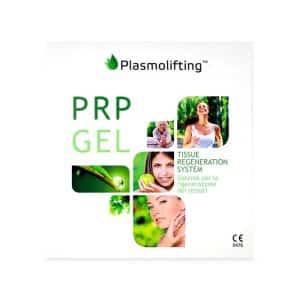Showing the single result
Buy PRP Kits from Leading Wholesaler
-


PLASMOLIFTING™ PRP GEL
10-9ml tubes
189.00 $ Add To Cart-+*Disclaimer: Information on Maylips.com is provided for informational purposes only. Self-medication is strictly prohibited. All aesthetic procedures should be provided by the licensed healthcare specialist after the consultation with the personal therapist. The information in this article should not be used for prescribing any medication for the beauty injections.
All brand and medication descriptions in the article are based on the personal opinion and are not endorsed by Maylips.com. The article content was not reviewed for medical validity. Use this article for information and not for a final decision on the procedure.
What is PRP therapy?
PRP stands for Platelet-Rich Plasma, a material derived from whole blood that is amplified in platelets and its associated growth factors and cytokines. The increased presence of signaling proteins like Transforming Growth Factor Beta (TGF-beta), Platelet Derived Growth Factor (PDGF), Fibroblast Growth Factor (FGF), Vascular Endothelial Growth Factor (VEGF), Insulin-like Growth Factor types 1 and 2 (IGFs), Epidermal Growth Factor (EGF) contribute to the propensity of PRP to encourage the healthy and accelerated regeneration of injured or damaged tissues.
PRP injections are used in many medical applications in various fields including orthopedics, plastic surgery, dental practice, and dermatology; due to its potential to encourage wound healing and tissue regeneration. These beneficial effects have led PRP to be used in medical aesthetics for the purposes of skin rejuvenation. Additionally, PRP injections can be used to help accelerate healing and enhance the results of aesthetic procedures. As an example, PRP can help to reduce edema and extend the effects of dermal filler treatment for longer-lasting results.What are the different types of PRP Kits used in aesthetic dermatology?
There are several different types of commercial PRP Kits currently available on the market; these can roughly be divided base on the method of separation. Some kits, including the Plasmolifting PRP kit are known as “gel separators”, which use an inert gel with physical properties that enable it to form a barrier between the platelet-containing plasma and the fraction containing erythrocytes and leukocytes when the sample is centrifuged. Other kits extract PRP using the “buffy coat” protocol, which isolates the “buffy coat” layer of a centrifuged sample as purely as possible. Buffy coat protocols usually incorporate a second centrifugation step to remove any contaminating red blood cells from the final product.
How is PRP therapy conducted?
PRP therapy typically transpires in three stages:
- Collection of whole blood: PRP is prepared from a whole blood sample collected from the patient. The volume required depends on the kit, but usually around 10ml is collected. Whole blood is taken from the patient through venipuncture using a butterfly needle.
- PRP harvesting: This step involves the separation of PRP from other blood cells using a centrifugation step. Whole blood separates into distinct layers upon centrifugation, with each layer containing different elements of blood. The desired layer, which is the portion containing the platelets, is extracted and transferred to a syringe, ready to be administered to the patient.
- PRP administration: The PRP is then administered to the patient. This can be done in many ways, depending on the application type. If PRP is used as mesotherapy for skin brightening and conditioning, the material is administered in microinjection over the treatment area using a 32G needle. If PRP is used to smooth fine lines and wrinkles, PRP may be administrated superficially into the dermis using a 30G needle. Suitable injection techniques such as cross-hatching, linear threading, or fanning may be employed for this purpose.
What are the post-procedural care methods?
Aftercare steps needed once a patient has undergone PRP therapy are minimal. It is advisable to refrain from excessively touching or manipulating the treatment area (e.g. avoiding massage), and to refrain from activities that may prolong bruising such as alcohol intake, taking certain herbal supplements, aspirin, and other anti-inflammatory medications.
What are the side effects of PRP therapy?
PRP treatments typically do not result in undesirable effects, as the material used is autologously derived, meaning that the blood cells injected in to the patient are their own. Any reactions that the patient experiences are usually due to the injection. In that aspect, side effects like redness, tenderness, and swelling are common, but are usually short-lived and self-resolving.
What are PRP Kits?
Commercial PRP Kits are collections of medical tools containing all that is needed to quickly and reliably prepare PRP for same-session treatment.
Maylips currently houses the Plasmolifting brand of PRP Kits. We not only stock the PRP kit itself, but also supply the peripheral lab equipment needed to perform PRP harvesting with the Plasmolifting protocol, including:- Plasmolifting PRP Gel – A PRP kit containing 10 x 9ml blood collection tubes which uses a thixotropic separating gel for PRP harvesting. The tubes also contain sodium citrate, an anti-coagulating agent added to prevent blood clotting.
- Plasmolifting PRP Centrifuge – A lab centrifuge provides the necessary separating step of the effective extraction of PRP. Two models are available: the XC 2000 and the XC 2415. These models are Plasmolifting-certified and intended solely to be used with the Plasmolifting regimen.
- Plasmolifting Incubator Mini B 100 – This instrument thermally processes PRP samples in order to alter the physical properties of the material so that it is appropriate for use as a soft tissue augmenting agent. The resultant product is a viscous, gel-like substance that still retains its collagen stimulating properties for biorevitalizing effects but may be used as a dermal filler to fill deeper skin creases and augment sunken areas.

